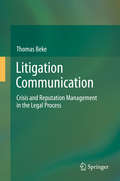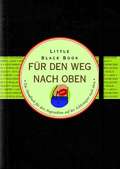- Table View
- List View
Literary Tourism: Theories, Practice and Case Studies
by Nadzeya Charapan Anniken Greve Humberto Fois-Braga Dr Warwick Frost Dr Jennifer Laing Lénia Marques Hanna Mikulich Madelene Blaer Kelley A. McClinchey Klaus Pfatschbacher Giulia Rossetti Alana N. Seaman Dr Anukrati Sharma Tom M.J. Sintobin Bernadette QuinnLiterary tourism is a nascent field in tourism studies, yet tourists often travel in the footsteps of well-known authors and stories. Providing a wide-ranging cornucopia of literary tourism topics, this book fully explores the interconnections between the written word and travel. It includes tourism stories using guidebooks, films, television and electronic media, and recognises that stories, texts and narratives, even if they cannot be classified as traditional travel writing, can become journeys in themselves and take us on imaginary voyages. Furthermore, the book: - Provides a grounding in the theoretical perspectives on literature and the tourist experience; - Explores practical applications of literary tourism, such as destination promotion and creation, responsible tourism and learning benefits; - Uses global case studies to study literary tourism in action. Appealing to a wide audience of different disciplines, it encompasses subjects such as business literary writing, historical journeys and the poetry of Dylan Thomas. The use of these different perspectives demonstrates how heavily and widely literature influences travel, tourists and tourism, making it an important read for researchers and students of tourism, social science and literature.
Literatur verstehen. Eine empirische Studie (Konzeption Empirische Literaturwissenschaft #9)
by Dietrich MeutschLiterature and Leadership: The Role of the Narrative in Organizational Sensemaking (Leadership Horizons)
by John R. Shoup Troy W. HinrichsGreat literature provides didactic commentaries on universal themes in the drama of life and visceral lessons on leadership. The careful reading of timeless novels position readers to emerge as astute protagonists in their own stories in the context of the grander narrative and internalize universal themes of the human story. Students of the great works of literature also emerge culturally literate, with a better understanding of themselves and others in relation to nobler virtues, traditions, and purposes. In addition to demonstrating great works of literature as among the first formal books on leadership, this book makes explicit connections between the study of literature and the research found in leadership and management studies. This book: Provides a bridge between the robust literary world and the leadership and management genre. Demonstrates how language and literature uniquely develop leaders to have a sophisticated understanding of historical and contemporary cultures, events, and people. Documents how powerful narratives either promote or diminish human flourishing. Illustrates the usefulness of all great literature and stories in shaping engaging and compelling workplace narratives that inspire and engage the collective. Equips leaders and managers with the knowledge and skills to embrace the drama of leadership and engage in meaningful sensemaking to help organizations thrive. Encourages readers to be connoisseurs of great works of literature and include such works in their leadership libraries. This book is ideal for the initiated and uninitiated in the study of literature and leadership by making explicit complementary and relevant insights to make reading and leading much more meaningful. Those unfamiliar with great literature will gain a deeper appreciation for books serving as tutors and mentors in the ways of leadership and become more discerning readers. Those unfamiliar with the leadership genre will improve their acumen to use endearing and enduring narratives to influence people and organizations.
Literature and Leadership: The Role of the Narrative in Organizational Sensemaking (Leadership Horizons)
by John R. Shoup Troy W. HinrichsGreat literature provides didactic commentaries on universal themes in the drama of life and visceral lessons on leadership. The careful reading of timeless novels position readers to emerge as astute protagonists in their own stories in the context of the grander narrative and internalize universal themes of the human story. Students of the great works of literature also emerge culturally literate, with a better understanding of themselves and others in relation to nobler virtues, traditions, and purposes. In addition to demonstrating great works of literature as among the first formal books on leadership, this book makes explicit connections between the study of literature and the research found in leadership and management studies. This book: Provides a bridge between the robust literary world and the leadership and management genre. Demonstrates how language and literature uniquely develop leaders to have a sophisticated understanding of historical and contemporary cultures, events, and people. Documents how powerful narratives either promote or diminish human flourishing. Illustrates the usefulness of all great literature and stories in shaping engaging and compelling workplace narratives that inspire and engage the collective. Equips leaders and managers with the knowledge and skills to embrace the drama of leadership and engage in meaningful sensemaking to help organizations thrive. Encourages readers to be connoisseurs of great works of literature and include such works in their leadership libraries. This book is ideal for the initiated and uninitiated in the study of literature and leadership by making explicit complementary and relevant insights to make reading and leading much more meaningful. Those unfamiliar with great literature will gain a deeper appreciation for books serving as tutors and mentors in the ways of leadership and become more discerning readers. Those unfamiliar with the leadership genre will improve their acumen to use endearing and enduring narratives to influence people and organizations.
Literature for the People: How The Pioneering Macmillan Brothers Built a Publishing Powerhouse
by Sarah HarknessFrom an impoverished childhood in the Scottish highlands to Victorian London, this is the inspiring story of two brothers – Daniel and Alexander Macmillan – who built a publishing empire - and brought Alice in Wonderland to the world. Their remarkable achievements are revealed in this entertaining, superbly researched biography.Daniel and Alexander arrived in London in the 1830s at a crucial moment of social change. These two idealistic brothers, working-class sons of a Scottish crofter, went on to set up a publishing house that spread radical ideas on equality, science and education across the world. They also brought authors like Lewis Carroll, Thomas Hardy and Charles Kingsley, and poets like Matthew Arnold and Christina Rossetti, to a mass audience. No longer would books be just for the upper classes.In Literature for the People Sarah Harkness brings to life these two warm-hearted men. Daniel was driven by the knowledge that he was living on borrowed time, his body ravaged by tuberculosis. Alexander took on responsibility for the company as well as Daniel’s family and turned a small business into an international powerhouse. He cultivated the literary greats of the time, weathered controversy and tragedy, and fostered a dynasty that would include future prime minister Harold Macmillan.Including fascinating insights about the great, the good and the sometimes wayward writers of the Victorian era, with feuds, friendships and passionate debate, this vibrant book is bursting with all the energy of that exciting period in history.
Literature Incorporated: The Cultural Unconscious of the Business Corporation, 1650-1850
by John O'BrienLong before Citizens United and modern debates over corporations as people, such organizations already stood between the public and private as both vehicles for commerce and imaginative constructs based on groups of individuals. In this book, John O’Brien explores how this relationship played out in economics and literature, two fields that gained prominence in the same era. Examining British and American essays, poems, novels, and stories from the seventeenth through the nineteenth centuries, O’Brien pursues the idea of incorporation as a trope discernible in a wide range of texts. Key authors include John Locke, Eliza Haywood, Harriet Martineau, and Edgar Allan Poe, and each chapter is oriented around a type of corporation reflected in their works, such as insurance companies or banks. In exploring issues such as whether sentimental interest is the same as economic interest, these works bear witness to capitalism’s effect on history and human labor, desire, and memory. This period’s imaginative writing, O’Brien argues, is where the unconscious of that process left its mark. By revealing the intricate ties between literary models and economic concepts, Literature Incorporated shows us how the business corporation has shaped our understanding of our social world and ourselves.
Literature Incorporated: The Cultural Unconscious of the Business Corporation, 1650-1850
by John O'BrienLong before Citizens United and modern debates over corporations as people, such organizations already stood between the public and private as both vehicles for commerce and imaginative constructs based on groups of individuals. In this book, John O’Brien explores how this relationship played out in economics and literature, two fields that gained prominence in the same era. Examining British and American essays, poems, novels, and stories from the seventeenth through the nineteenth centuries, O’Brien pursues the idea of incorporation as a trope discernible in a wide range of texts. Key authors include John Locke, Eliza Haywood, Harriet Martineau, and Edgar Allan Poe, and each chapter is oriented around a type of corporation reflected in their works, such as insurance companies or banks. In exploring issues such as whether sentimental interest is the same as economic interest, these works bear witness to capitalism’s effect on history and human labor, desire, and memory. This period’s imaginative writing, O’Brien argues, is where the unconscious of that process left its mark. By revealing the intricate ties between literary models and economic concepts, Literature Incorporated shows us how the business corporation has shaped our understanding of our social world and ourselves.
Literature Incorporated: The Cultural Unconscious of the Business Corporation, 1650-1850
by John O'BrienLong before Citizens United and modern debates over corporations as people, such organizations already stood between the public and private as both vehicles for commerce and imaginative constructs based on groups of individuals. In this book, John O’Brien explores how this relationship played out in economics and literature, two fields that gained prominence in the same era. Examining British and American essays, poems, novels, and stories from the seventeenth through the nineteenth centuries, O’Brien pursues the idea of incorporation as a trope discernible in a wide range of texts. Key authors include John Locke, Eliza Haywood, Harriet Martineau, and Edgar Allan Poe, and each chapter is oriented around a type of corporation reflected in their works, such as insurance companies or banks. In exploring issues such as whether sentimental interest is the same as economic interest, these works bear witness to capitalism’s effect on history and human labor, desire, and memory. This period’s imaginative writing, O’Brien argues, is where the unconscious of that process left its mark. By revealing the intricate ties between literary models and economic concepts, Literature Incorporated shows us how the business corporation has shaped our understanding of our social world and ourselves.
Literature Incorporated: The Cultural Unconscious of the Business Corporation, 1650-1850
by John O'BrienLong before Citizens United and modern debates over corporations as people, such organizations already stood between the public and private as both vehicles for commerce and imaginative constructs based on groups of individuals. In this book, John O’Brien explores how this relationship played out in economics and literature, two fields that gained prominence in the same era. Examining British and American essays, poems, novels, and stories from the seventeenth through the nineteenth centuries, O’Brien pursues the idea of incorporation as a trope discernible in a wide range of texts. Key authors include John Locke, Eliza Haywood, Harriet Martineau, and Edgar Allan Poe, and each chapter is oriented around a type of corporation reflected in their works, such as insurance companies or banks. In exploring issues such as whether sentimental interest is the same as economic interest, these works bear witness to capitalism’s effect on history and human labor, desire, and memory. This period’s imaginative writing, O’Brien argues, is where the unconscious of that process left its mark. By revealing the intricate ties between literary models and economic concepts, Literature Incorporated shows us how the business corporation has shaped our understanding of our social world and ourselves.
Literature Reviews: Modern Methods for Investigating Scientific and Technological Knowledge
by Ana Paula Cardoso Ermel D. P. Lacerda Maria Isabel Morandi Leandro GaussThis book begins by introducing the topic of knowledge in literature, including its scientific foundations. Due to the ever-increasing number of scientific publications, literature reviews are becoming more and more essential to stay updated. Literature Reviews describes an innovative system for creating systematic literature reviews, through reviewing, analyzing, and synthesizing scientific and technological literature. It then discusses systematic literature reviews, content analysis, and literature synthesis separately, before presenting the methodology to combine them in one process. It showcases computational tools to aid in this technique and offers examples of the method in action. Finally, the book takes a new of future developments in the subject. This book is of interest to graduate students, as well as researchers and academics, helping them to deepen insights and improve skills needed to conduct thorough literature reviews.
Lithium-Ion Batteries Hazard and Use Assessment (SpringerBriefs in Fire)
by Celina Mikolajczak Michael Kahn Kevin White Richard Thomas LongLithium-Ion Batteries Hazard and Use Assessment examines the usage of lithium-ion batteries and cells within consumer, industrial and transportation products, and analyzes the potential hazards associated with their prolonged use. This book also surveys the applicable codes and standards for lithium-ion technology. Lithium-Ion Batteries Hazard and Use Assessment is designed for practitioners as a reference guide for lithium-ion batteries and cells. Researchers working in a related field will also find the book valuable.
Litigation and Settlement in a Game with Incomplete Information: An Experimental Study (Lecture Notes in Economics and Mathematical Systems #440)
by Wolfgang RyllWe investigate a two-person game of litigation and settlement with incomplete information on one side. So far, various theoretical attempts have been made to answer the question of why some people choose not to resolve their disputes and instead go to court and incur litigation costs, even if bargaining leaves room for both parties to fare better when avoiding the conflict. We can distinguish between games which focus on strategic elements like games with incomplete information (see, for example, P'ng (1983), Samuelson (1982) and Schweizer (1989» and decision-theoretic models neglecting strategic elements (see, for example, Landes (1971) and Gould (1973». The single-person decision theory approach to litigation assumes litigants to have a subjective estimate of the likelihood that the plaintiff will win the action. Differing views on the probability of winning the court case help to explain the fraction of cases that actually go to trial. Among others, P'ng (1983) points out the shortcomings of the single-person decision theory approach which does not take into account, for example, the different fee systems in England and the U.S. and the differences in information conflicting parties may have. P'ng constructs a model of one-sided incomplete information where the settlement terms are given exogenously. Schweizer (1989), on the other hand, extends P'ng's model and allows for two-sided asymmetric information where the settlement terms are determined endogenously.
Litigation Communication: Crisis and Reputation Management in the Legal Process
by Thomas BekeThe book is a brief journey through centuries and jurisdictions and expands on examples of enactment practices of states that support, challenge or even reject communication during pending litigations. England, as the main representative of a jurisdiction, suggests communication solutions potentially different than the practice in the United States where litigation communication first time occurred. Accordingly, the author offers a comprehensive analysis and detailed historical narrative of the positions of various jurisdictions in relation to communication in the legal process. As a kind of applied legal history, the book provides an exploration of historical events that were significant in a legal communication context and addresses their implications for modern enactments. The account looks at the history of regulations to allow a better understanding of the strict rules that have often been cited over the years support or restrict communication in the legal process. The author provides the reader with proper contexts on different judicial and communication considerations, as well as the collaboration of legal and public relations experts, in a particular form of crisis and reputation management, in the litigation process. As such, this book is an attempt to present an accurate and thoughtful account of the theory and history of litigation communication, which is directly relevant in various debates such as the work on the meaning and context of the Contempt of Court Act in England or the American First and Sixth Amendments in different centuries.
Litigation-PR: Wie Krisenkommunikation im Gerichtssaal der Öffentlichkeit funktioniert
by Martin WohlrabeEin Unternehmen, das in einen Rechtsstreit verwickelt ist, muss heute nicht mehr nur die Richter überzeugen – sondern auch die Öffentlichkeit. Denn was nützt eine gewonnene juristische Auseinandersetzung, wenn dabei die Reputation verloren geht? Dieses Buch will Anwälte, Sprecher und Manager auf den Tag X vorbereiten: auf den Moment, wenn der Ruf von Klienten auf dem Spiel steht. Die Autoren berichten, wie sie PR-Krisen erlebt und gelöst haben. Sie erklären, wie Medien funktionieren. Und sie geben Tipps, wie man im Gerichtssaal der Öffentlichkeit besteht. Die praxisnahen Beiträge und Interviews befassen sich unter anderem damit,welche Strategien bei Litigation-PR und Krisen-PR erfolgversprechend sind,was strategische Rechtskommunikation in verschiedenen Rechtsgebieten leisten kann,welche Erfahrungen Betroffene im Umgang mit medialen Krisen gemacht haben,wie Journalisten bei Rechtsstreitigkeiten recherchieren und berichten sowiewelche juristischen Aspekte in der Kommunikation zu berücksichtigen sind.Der HerausgeberRA Martin Wohlrabe war viele Jahre als Journalist für die Wirtschaftsredaktion der BILD-Zeitung tätig. Außerdem schrieb er für SPIEGEL Online und sammelte Erfahrung in der SPIEGEL-Gerichtsreportage. Darüber hinaus arbeitete Wohlrabe als Referent von Wolfgang Schäuble im Deutschen Bundestag und verantwortete dort die Pressearbeit des Ministers mit. Wohlrabe ist Gesellschafter der Litigation- und Krisen-PR-Agentur CONSILIUM, die unter anderem den jährlichen Rechtskommunikationsgipfelausrichtet, und Lehrbeauftragter für Strategische Rechtskommunikation an der Universität Freiburg.Die Beitragsautoren und InterviewpartnerDr. Thomas Middelhoff (Autor)Gernot Lehr (Redeker Sellner Dahs)Martin U. Müller (Der Spiegel)Jens-Oliver Voß (Deutsche Bahn)Andrea Titz (Amtsgericht Wolfratshausen)Prof. Dr. Christoph Knauer (Ufer Knauer Rechtsanwälte)Pia Lorenz (Legal Tribune Online)Dr. Sebastian Rudolph (Bilfinger SE)Joachim Wolbergs (langjähriger Oberbürgermeister Regensburg)Tobias Vogl (FDP-Fraktion im Bayerischen Landtag)Prof. Dr. Matthias Jahn (Goethe-Universität Frankfurt)Dr. Fabian Meinecke (Olfen Meinecke Völger)Prof. Dr. Hans Mathias Kepplinger, Pablo Jost (Johannes Gutenberg-Universität Mainz)Karin Matussek (Bloomberg News)Prof. Dr. Patrick L. Krauskopf, Seraina Gut (ZHAW Winterthur)Thomas Seeger (Alfred Ritter GmbH & Co. KG)Prof. Dr. Alfred Hagen Meyer (Meyer Rechtsanwälte)Martin Wohlrabe, Lou Siebert, Franziska Seusing, Arianna Elsässer, Ann-Katrin Adriaans (ConsiliumRechtskommunikation GmbH)
Litigation Support Report Writing: Accounting, Finance, and Economic Issues
by Jack P. Friedman Roman L. WeilA comprehensive collection of effective litigation reports on a variety of subjects Accounting, financial, appraisal, and economic experts called upon to provide expert testimony in legal proceedings need reliable models for the critical documents they will submit to the court. Litigation Support Report Writing collects eighteen exemplary reports from a variety of financial topics, providing professionals a comprehensive resource on this vital function. Order your copy today.
Little America: The War Within The War For Afghanistan
by Rajiv ChandrasekaranThe US Government invested millions in Helmand in the 1950s and '60s to transform the barren desert into a veritable oasis - known locally as 'Little America' - and then the money ran out. Four decades later, Helmand was again the focus of US efforts, as waves of Marines descended on the region. Little America tells the story of the long arc of American involvement, and of the campaign to salvage a victory in southern Afghanistan on Obama's watch. Has the war been worth the money and the bloodshed? Through vivid storytelling and on-the-ground reporting, Samuel Johnson Prize-winner, Rajiv Chandrasekeran sets out to find the answer.
Little Bets: How breakthrough ideas emerge from small discoveries
by Peter SimsHow did Pixar go from producing CAT scan images to winning Oscars?How did Steve Jobs turn Apple into a world-beating company?How does Amazon's culture encourage innovation?How can you find the creative solutions demanded by our ever-changing world?The answer, according to renowned business thought-leader Peter Sims, is LITTLE BETS. In these fast-moving times, it's next to impossible to predict what's around the corner, and harder still to formulate a foolproof plan to deal with it. Truly innovative companies, Sims argues, don't get caught up in projections and predictions. Instead, they embrace uncertainty, take a chance, fail quickly and learn fast. This method has formulated thousands of modern advances, from Google's PageRank to Starbucks coffee shops - if you harness its power, what could you achieve?
The Little Big Number: How GDP Came to Rule the World and What to Do about It
by Dirk PhilipsenIn one lifetime, GDP, or Gross Domestic Product, has ballooned from a narrow economic tool into a global article of faith. As The Little Big Number demonstrates, this spells trouble. While economies and cultures measure their performance by it, GDP only measures output. It ignores central facts such as quality, costs, or purpose. Sustainability and quality of life are overlooked. Losses don't count. The world can no longer afford GDP rule—GDP ignores real development. Dirk Philipsen demonstrates how the history of GDP reveals unique opportunities to fashion smarter goals and measures. The Little Big Number explores a possible roadmap for a future that advances quality of life rather than indiscriminate growth.
The Little Big Number: How GDP Came to Rule the World and What to Do about It
by Dirk PhilipsenIn one lifetime, GDP, or Gross Domestic Product, has ballooned from a narrow economic tool into a global article of faith. As The Little Big Number demonstrates, this spells trouble. While economies and cultures measure their performance by it, GDP only measures output. It ignores central facts such as quality, costs, or purpose. Sustainability and quality of life are overlooked. Losses don't count. The world can no longer afford GDP rule—GDP ignores real development. Dirk Philipsen demonstrates how the history of GDP reveals unique opportunities to fashion smarter goals and measures. The Little Big Number explores a possible roadmap for a future that advances quality of life rather than indiscriminate growth.
Little Black Book: A Toolkit For Working Women
by Otegha Uwagba‘Little Black Book is THE book of the year for working women with drive’ Refinery 29 The essential career handbook for creative working women. ‘A compact gem’ Stylist
Little Black Book: A Toolkit For Working Women
by Otegha UwagbaThe essential career handbook for creative working women.
The Little Black Book for Managers: How to Maximize Your Key Management Moments of Power
by John Cross Rafael Gomez Kevin MoneyA smart, small book for any manager’s pocket. In every manager’s career there are moments where decisions need to be made in order to achieve success and this smart, nicely packaged little book can be there to help each time. The trick to succeeding in these moments is to identify each of these situations ahead of time and understand how to act and what to do to reduce the chances of failure. That is exactly what The Little Black Book for Managers has done. The authors have listed a whole host of situations most managers face, based on thousands of personal experiences, and have mapped out how to deal with each situation. The book contains specific examples of words and phrases that can be used as well as illustrations and exercises to analyse your current performance. It is short on waffle and high on practical wisdom. It is designed to be dipped in and out of – reached for whenever a situation arises. This is a practical support tool for managers at all levels, from shop-floor supervisor to main board director. The Little Black Book for Managers explains how to deal with scenarios such as; Having a lack of confidence to deal with other people in the way that is needed Times when you have to assert your authority more Allocating critical work. Who to choose? Needing to get extra effort from the team when under pressure Incentivising Delegation Having to deal with under-performers Personality clashes between work colleagues Managing a meeting with senior leaders
The Little Black Book for Managers: How to Maximize Your Key Management Moments of Power
by John Cross Rafael Gomez Kevin MoneyA smart, small book for any manager’s pocket. In every manager’s career there are moments where decisions need to be made in order to achieve success and this smart, nicely packaged little book can be there to help each time. The trick to succeeding in these moments is to identify each of these situations ahead of time and understand how to act and what to do to reduce the chances of failure. That is exactly what The Little Black Book for Managers has done. The authors have listed a whole host of situations most managers face, based on thousands of personal experiences, and have mapped out how to deal with each situation. The book contains specific examples of words and phrases that can be used as well as illustrations and exercises to analyse your current performance. It is short on waffle and high on practical wisdom. It is designed to be dipped in and out of – reached for whenever a situation arises. This is a practical support tool for managers at all levels, from shop-floor supervisor to main board director. The Little Black Book for Managers explains how to deal with scenarios such as; Having a lack of confidence to deal with other people in the way that is needed Times when you have to assert your authority more Allocating critical work. Who to choose? Needing to get extra effort from the team when under pressure Incentivising Delegation Having to deal with under-performers Personality clashes between work colleagues Managing a meeting with senior leaders
Little Black Book für den Weg nach oben: Das Handbuch Für Den Weg Nach Oben (Little Black Books (Deutsche Ausgabe))
by Nicholas NoyesHerkules hatte die Wahl: Ein steiniger entbehrungreicher Weg oder ein einfacher, leichter mit Gold gepflasterter. Er wählte den steinigen, Herkules ist tot. Mit Fleiß, Intelligenz und Entbehrung kann jeder Erfolg haben. Das »Little Black Book für den Weg nach oben« zeigt Ihnen, dass es auch anders geht. Bierernst erklärt Ihnen dieser Ratgeber, wie Sie als durchschnittlich begabter Mitarbeiter mit überschaubarem Ehrgeiz zu etwas kommen können. Getreu dem Motto: Schmeicheln statt malochen stellt Ihnen Nicholas Noyes den ältesten Karrieremotor der Welt vor, wie Sie ihn ölen und in Schuss halten. Wer dann auf Ihrer Schleimspur ausrutscht, ist selbst schuld. WARNUNG: Schenken Sie dieses Buch auf keinen Fall einem Kollegen!
The Little Black Book of Change: The 7 fundamental shifts for change management that delivers
by Paul Adams Mike StrawYour go-to-guide to delivering effective and transformative change that lasts All too often, change efforts fail to deliver on their promise. However it is possible to turn an organization around quickly to create a new future — one where people think and behave differently and deliver extraordinary results together. Whether you are the chairman, a board director or an aspiring senior executive, The Little Black Book of Change provides a practical, concise and insightful guide to understanding your organization and inventing something extraordinary. It is not about ‘run of the mill' change programmes. It is about delivering extraordinary results — something that is not at all predictable. It will be your insight into creating significant shifts in the way people think and behave which can be applied in any area you wish; from improving service levels to cost reductions, innovation or increasing market share. Demystifies organisational transformation in 7 practical steps Based on real business case studies Grounded and accessible, rather than purely from theoretical models or processes The authors have 25 years' experience of implementing and facilitating transformations change Visit http://www.littleblackbookofchange.com/


















